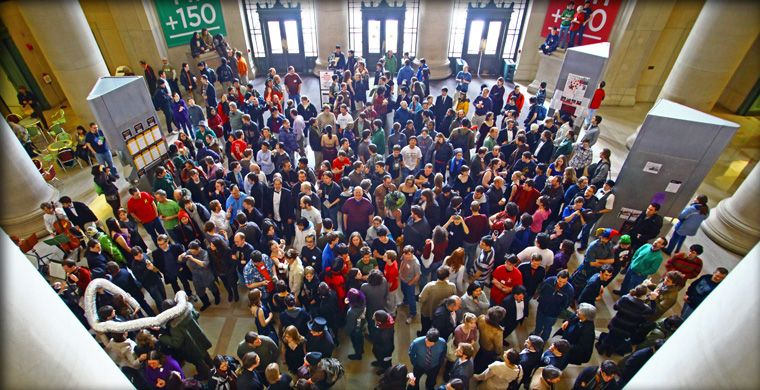History of the Mystery Hunt

The MIT Mystery Hunt is an annual event which has taken place on the MIT campus every year since 1981. The hunt was created by Brad Schaefer, at the time a PhD student at MIT. Brad organized the first hunt that January, and every year until he left the institute in 1983. From that point on, the team which won the hunt was awarded with the right to create the hunt in the subsequent year.
Traditionally, the hunt begins at noon on the Friday in January before Martin Luther King Jr. Day, during MIT's Independent Activity Period (IAP). At the start of the hunt, all of the teams congregate in Kresge Auditorium (originally, it was in MIT's Lobby 7 as seen above), where the hunt organizers reveal the year's theme in an opening skit and pass out starting materials. The teams then adjourn to their bases and access the first puzzles of the hunt online. Teams may consist of any number of people, from around a dozen to over a hundred! Large teams often have a significant percentage of their members participating remotely through email, phone, video-conferencing, instant messaging and team wikis.
Early hunts had between 30 and 40 puzzles; however, in recent years, that number has increased dramatically (some reaching 200!). The 2013 hunt, the longest on record at more than 75 hours (!), had over 150 puzzles. These puzzles can be crosswords, anagrams, cryptograms, number puzzles, multimedia puzzles, geometrical puzzles, physical challenges, mystery trails, scavenger hunts, inter-team games, or anything else that the hunt organizers can think up. The puzzles may or may not be obvious, may or may not have instructions, and (rarely) may not even be solvable!
Puzzles often require knowledge of the MIT campus and culture. Although it is not required that all participants have an MIT affiliation, most teams with current MIT students have some advantages.
It typically takes about 48 hours of hard work for a team to solve the puzzles, with the answers to all of the puzzles coming together to lead the teams to the location of a coin hidden somewhere on the MIT campus. During this time, teams report their progress to the hunt organizers, verify individual puzzle answers, and clarify certain questions they may have.
As mentioned above, the winning team is awarded the right to organize the following year's hunt, which includes the right to redefine almost any of the hunt's rules. This tradition leads to many creative and unusual hunts but also guarantees that the same people cannot be involved in creating a hunt for two years in a row.
If you'd like to read more about the hunt's history, check out the Wikipedia article on Mystery Hunt, and the article from the Games magazine by Eric Albert.